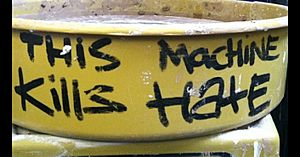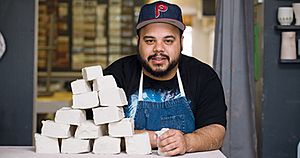Roberto Lugo facts for kids
Quick facts for kids
Roberto Lugo
|
|
|---|---|
| Born | 1981 (age 43–44) |
| Nationality | American |
| Education | Kansas City Art Institute (BFA), Pennsylvania State University (MFA) |
| Occupation | potter, poet, educator |
Roberto Lugo (born in 1981) is an American artist. He is known for his amazing pottery, his work as a social activist, and his spoken-word poetry. He is also an educator.
Lugo's art often combines different ideas. He mixes hip-hop culture, history, and politics with his own background. He uses these ideas in his ceramic art and other artworks.
Roberto Lugo was born in the Kensington area of Philadelphia. His parents came from Puerto Rico. Before he became a famous potter, he started as a graffiti artist and a teacher.
He studied art at the Kansas City Art Institute and Pennsylvania State University. He also taught ceramics at the Tyler School of Art. In 2019, he won the Rome Prize, which is a special award for artists. His unique art has become very popular across the country.
Contents
Early Life and Discovering Art
Roberto Lugo was born in Philadelphia in 1981. He was the third child in his family. His parents had moved to the U.S. from Puerto Rico. His mother, Maribel Lugo, was 21. His father, Gilberto, was a preacher. His father had worked in sugar-cane fields in Puerto Rico since he was a child.
Growing up, things were not easy for the Lugo family. His father often rode his bike far away to find work. Roberto thinks of his father's bike when he works on his pottery. He says this idea always makes him want to achieve more. His mother worked many part-time jobs to help the family. She also took care of the three children.
Roberto was a quiet child. He was very religious and had a strong Spanish accent. He also had trouble reading. His teachers did not always see his creative talents.
As a teenager, he liked grunge rock music and ice hockey. This was different from what other kids in his neighborhood liked. To fit in better, he started writing graffiti with his cousins. He used the tag "Robske." He still uses this tag on all his art today. He believes graffiti helped him start his art career.
When he was 22, Roberto moved to South Florida. He wanted to decide what to do with his life. He thought college could help him get a good job. So, he took a ceramics class at a community college. He learned that true art comes from your own experiences. He made art that reminded him of happy memories. For example, he made a fire hydrant. It reminded him of showering in the street with his father when their water was turned off. He said it was the first time someone told him he was good at something. Art quickly became his passion.
Education and Important Projects
In 2007, Roberto Lugo studied briefly at the School of the Art Institute of Chicago. Then, he joined the ceramics program at the Kansas City Art Institute. He graduated with his art degree in 2012. He loved learning about the history of ceramics. He was interested in how pots can tell stories about past cultures.
He found connections between old ceramics and his own graffiti art. For example, lines on a Chinese pot looked like graffiti arrows. He started drawing graffiti on his pottery using special paint. This allowed him to add his own style to art history. He also realized that artists of color were not often seen in the art world. He felt he could speak for people from his background through his art.
His sense of purpose grew when he started graduate school in 2012. He studied at Pennsylvania State University School of Visual Arts. Around this time, his brother faced a difficult situation. Feeling sad and angry, Roberto created a powerful artwork called Oppression. It showed the heads of two men of color, including himself and his brother. They were placed on a fancy teacart, like saucers for dripping cups.
In 2013, he worked on a project about young people in prison. A photographer named Richard Ross invited him to help with a show called Juvenile in Justice. This show was in Philadelphia. Roberto felt strong and believed his voice was important to the ceramics community.
NCECA Conference 2015
In late 2014, Roberto Lugo was chosen as an Emerging Artist for the National Council on Education in Ceramic Arts (NCECA) conference. This big event happened in Providence, Rhode Island in 2015. Lugo gave a very personal speech. It was part spoken-word performance and part inspiring talk. Nearly 5,000 people listened.
He spoke about how pottery saved his life. He even showed a picture of his pottery wheel with the words "This machine kills hate" painted on it. The audience gave him a standing ovation. He said, "I am proud to be a part of a community of people that honors the things I just talked about, that finds those things valuable… We’re a culture that can change the world." The video of his speech has been watched almost 20,000 times online. Many people have thanked him and shared their own similar experiences.
Recent Work and Activism
After the NCECA conference, a gallery in his hometown contacted Lugo. Wexler Gallery in Philadelphia now shows his work. In June 2016, they had his first solo show called Defacing Adversity: The Life and Times of Roberto Lugo.
Like all his art, Defacing Adversity explores important topics. It talks about social justice, politics, race, and poverty. He uses beautiful, historical ceramic shapes to do this. By mixing graffiti, hip-hop, history, and pop culture with fine porcelain, Lugo brings new ideas to the art world. In 2021, Lugo's ceramic piece Digable Underground was shown at the Metropolitan Museum of Art. This artwork featured Harriet Tubman and Erykah Badu.
Besides creating art for shows, Lugo has been very busy. He has done short art residencies in places like The Clay Studio in Philadelphia. He gives talks to new ceramic artists and schools across the country. He also visits different places as a guest artist.
In 2015, he started teaching at Marlboro College in Vermont. He wanted to teach in a place that wanted to become more diverse. He has also shown his art at many exhibitions. These include SOFA Chicago and a solo show at Eutectic Gallery in Portland, Oregon.
Lugo also works for social justice in other ways. He makes video diaries on social media. In these videos, he talks about race relations in the U.S. and diversity in the art field. He wants to inspire future artists to speak up for change. He has also helped social change groups like The Democratic Cup. Roberto Lugo is an assistant professor of art at Tyler School of Art.
Film About Roberto Lugo
A film called Without Wax was released in 2019. It was directed by Cyrus Duff and produced by Edward Columbia. The film explores Roberto Lugo's life and art. It shows how his past and present come together in his boundary-pushing work.
Art Style
Roberto Lugo's art has been compared to other famous artists. For example, Kehinde Wiley paints portraits of young people of color in heroic poses. Lugo's art also reminds people of Lin-Manuel Miranda's musical Hamilton. Hamilton uses hip-hop to tell the story of the American Revolution.
Lugo's pottery often looks like historical ceramic patterns. He especially likes Royal Worcester porcelain. He puts images of poverty and social injustice on these fancy porcelain pieces. This makes people think about these serious topics.
Lugo's art mixes many cultures. He takes traditional European and Asian porcelain shapes. Then, he adds a modern, street-art feel from the 21st century. His hand-painted surfaces have classic patterns, like those found on bandanas. They also include modern urban graffiti. He paints striking portraits of people you might not expect to see on luxury items. These include people like Sojourner Truth, Cornel West, and Erykah Badu. He also paints his family members and himself. Faces are often framed by colorful patterns. Sometimes, there's a strong contrast, like a confederate flag surrounding faces of people who faced discrimination. Lugo's art is bold and delivers strong messages with delicate brushstrokes.
Exhibitions
Lugo's art is part of the Afrofuturist Period Room exhibition. This show is called Before Yesterday We Could Fly and is at the Metropolitan Museum of Art.
Family Life
Roberto Lugo has two sons. He lives and works in Elkins Park, Pennsylvania.



